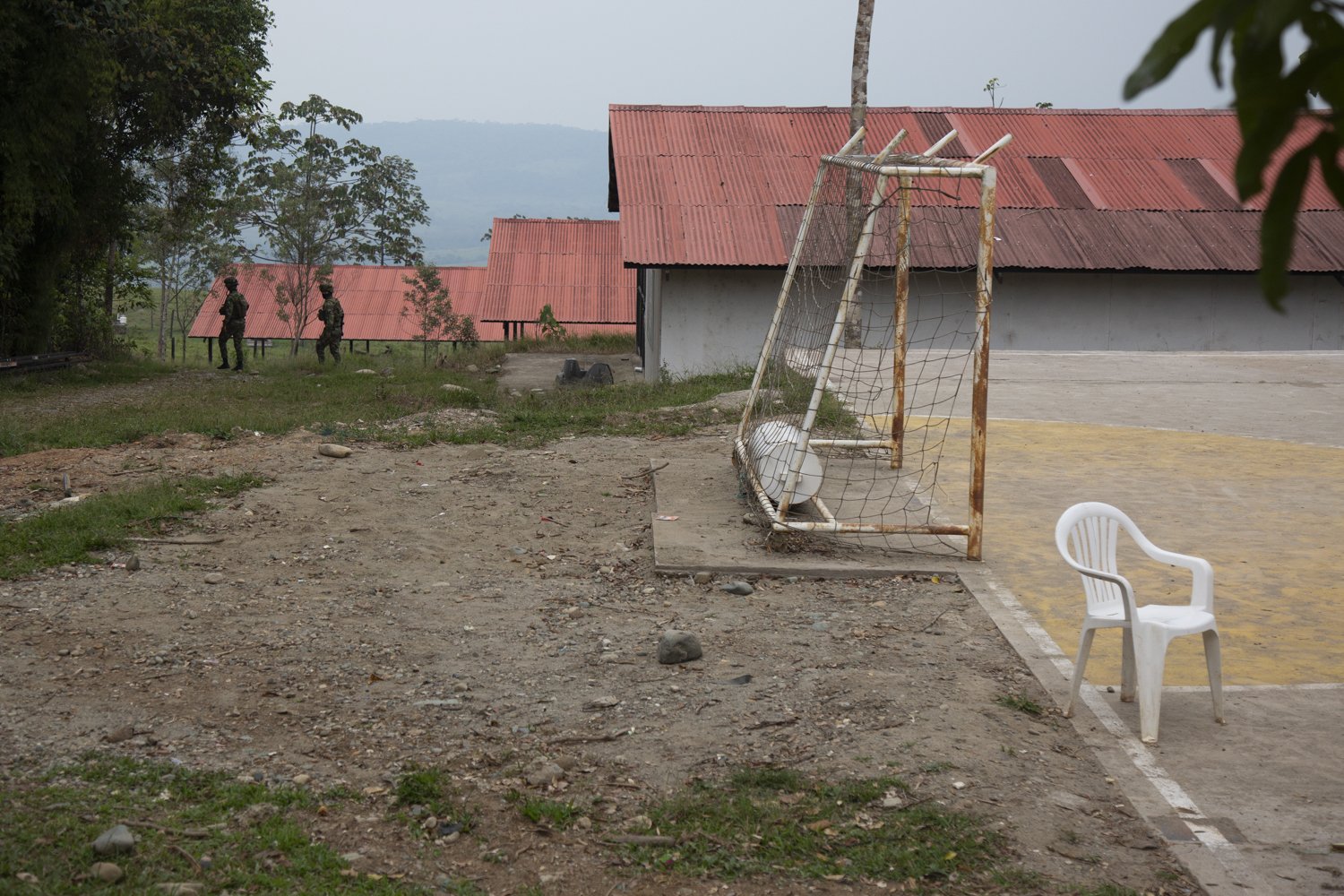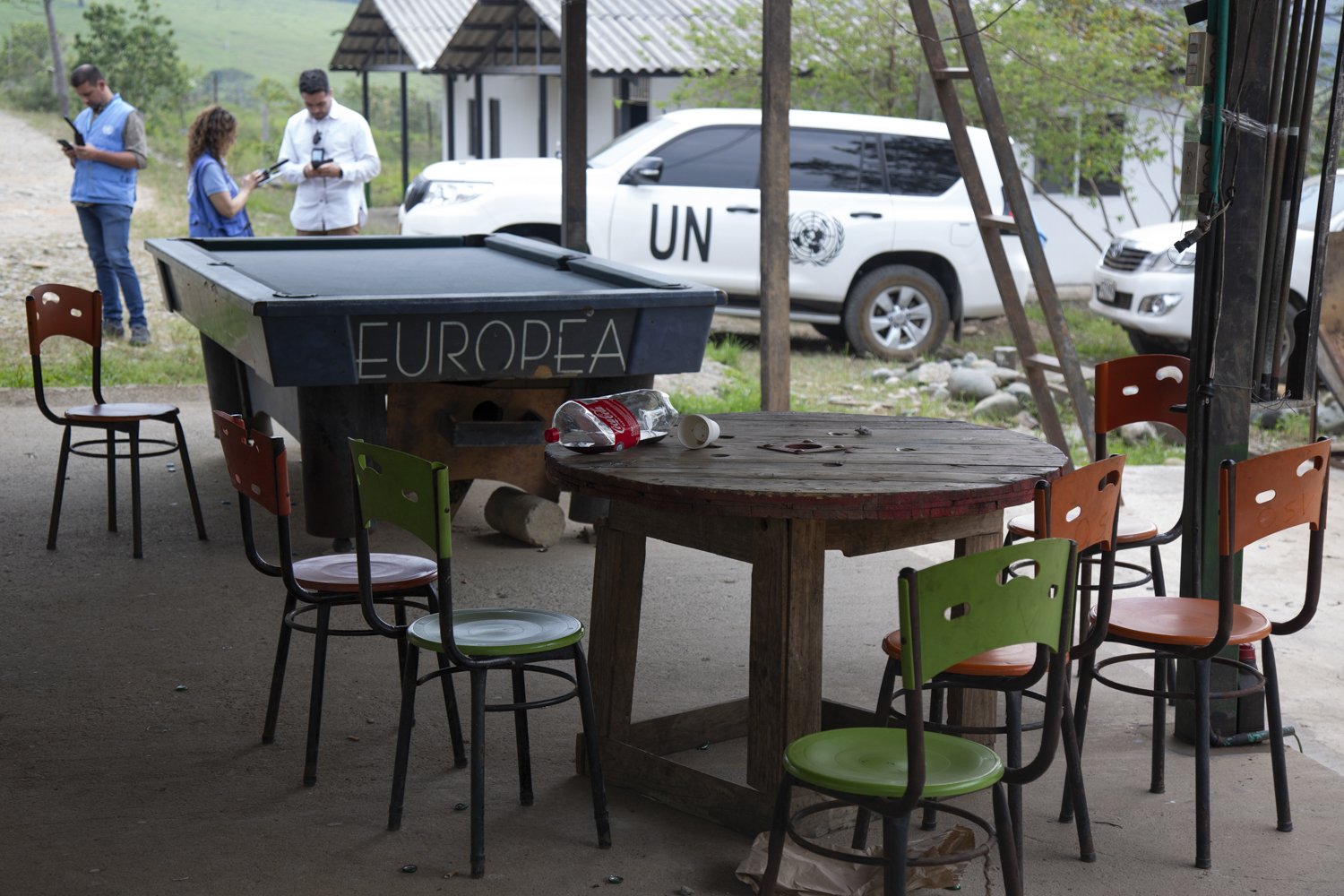Petro: Zones of transition, but toward what?
Responding to the forced displacement of former FARC combatants, Colombian President Gustavo Petro pledges commitment to implementation of 2016 peace accords.
March 29, 2023
Originally published by El Cuarto Mosquetero. Follow the link to read in the original Spanish.
White doves swirl around behind Ginger’s house in the ETCR Mariana Paez in Mesetas, Meta, March 29, 2023. They’re descendants of the original pair the former FARC combatant adopted after signing the peace accords in 2016 and embarking on a civilian life. She now prepares to leave the life she’s built, along with the more than 200 other families in the community, following threats from an illegal armed group operating in the area.
MESETAS, META—Not long after Ginger left the jungle with a baby in arms and started her life as a civilian on the borrowed land that was to be a temporary home for her and her fellow ex-combatants, she adopted two white doves.
As the years stretched on, six of them, and the federal government failed to deliver the permanent lands they had committed to in the 2016 peace accords with the Revolutionary Armed Forces of Colombia (FARC), the community grew to include more than 200 families–including 80 children–and 150 white doves.
But when a threat arrived on March 15 from an illegal armed group active in the area, all of them prepared to walk away from the life they had built in Mariana Paez, a Territorial Space for Training and Reincorporation (ETCR), or transitional housing community for ex-combatants.
They had been given thirty days to leave.
When I met Ginger, she was in the process of dismantling her home. The coop for the doves was one of the first things to go, and the bird population had dwindled to about 75. Many of her things were already in boxes, and she expected to be moving them–though she still didn’t know where to–in little more than a week.
Ginger’s belongings, including children’s toys, are seen piled into boxes outside of her mostly empty home March 29, 2023. Along with her fellow ex-combatants and their families, more than 200 of them, who make up the community of the Mariana Paez ETCR, she is preparing to leave behind the life she’s built there in the past six after the community received a threat from an ilegal armed group on March 15 giving them 30 days to relocate.
Earlier that day, the 29th of March, in a press conference ahead of the afternoon’s visit from the nation’s president, Gustavo Petro, leaders from her community had reiterated their decision to leave.
In the communique announcing that decision, they put it this way: “We consider the Colombian government to be incapable of offering us the promise of security, should we stay, in spite of their will to do so. They don’t have the sovereignty and control of the territories that could afford them that authority.”
Leaders from the ETCR of Mariana Paez reiterate their decision to flee following the threats of ilegal armed actors during a press conference held March 29, 2023. As she listens, a pregnant community member rubs her belly.
It’s not an overreaction. The same systematic lack of commitment to the peace accords that left the community stranded on borrowed land and full of mistrust, has generated a boom in armed groups fighting for control of the territory and killing those who stand in their way. Former FARC combatants face a particular risk, as many members of the group are themselves former guerrillas who claim to be carrying on the revolutionary fight, many of them having abandoned ETCRs to do so.
To date, 348 have been assassinated in the six years since the peace accords were signed.
Throughout the morning’s sessions with representatives from government agencies, international human rights organizations and local leaders, the community hadn’t changed their position.
At around four in the afternoon, the sound of a helicopter announced the president’s arrival, breaking the slow tension that had settled on the afternoon. In the pavilion, the community filled the chairs with matching white t-shirts marked with a hand-print in the shape of a dove with the words “for life, for peace.”
Residents of the Mariana Paez ETCR in Mesetas, Meta, crown into the community’s meeting space as they wait for a visit from the nation’s president, Gustavo Petro, March 29, 2023, wearing shirts and hats that read “for life, for peace.” This will be the new leftist leader’s first visit to an ETCR since taking office.
They waited while leaders from the ETCR hashed out the details of their futures with the president and top officials from branches of government that had consistently failed to deliver on their promises.
Just before Christmas of 2021, the population of a neighboring ETCR was forced to vacate their homes after armed men burned the vehicles of their government-assigned protection units, and a member of the community was assassinated. They had been denouncing the escalation of the threats to the state for more than a year.
For the evacuation itself, the ex-combatants turned down the use of government helicopters to avoid bringing more risk to remaining community members by adding to the militarization in the region. Having chosen to go by land, their caravan was attacked with gunfire en route.
Gallery: Scenes from Mariana Paez
When he emerged from more than an hour of negotiations with community leaders and federal officials, Petro shook hands and posed for photos in the late afternoon light before taking his seat at the high table.
Rodrigo Londoño, the former commander-in-chief of the FARC and current president of the political party they founded after the accords, read haltingly from a laptop the terms the community had agreed to: They would stay in the ETCR, with the permanent presence of government agencies and human rights organizations, for no more than three months while they worked with the government to secure the purchase of favorable lands, with the guarantee of the immediate departure in the event of a breakdown of negotiations with the dissident group that had issued the threat.
Just the day before the self-proclaimed Estado Mayor Central de las FARC-EP issued the threat to Mariana Paez, Petro announced via twitter that his government would begin negotiations with the dissident group as part of his Total Peace initiative, which seeks to reach agreements with all of the armed groups operating throughout the country.
While his administration has been publicly focused on securing new peace agreements, when he finally took the podium this Wednesday Petro acknowledged how much work remained to be done on the one his administration had inherited.
“The peace accords, in reality, have not been completed,” he stated. “There is an enormous distance between the objectives of the accord and the institutions we’ve been left to implement those accords. And there begins the disaster.”
While he blamed previous administrations for sabotaging the state’s ability to follow through by sewing red tape and hollowing out key agencies, he pledged to convert his cabinet into a “cabinet of peace,” and create a position to oversee implementation of the peace deal with the FARC, especially the delivery of three million hectares for landless farmers.
“Well, if we’re going to come through with 3 million hectares, then we can come through with 10 thousand hectares for all the people and families that are in these types of spaces, in a transition that many of these families still don’t know where to,” he pledged. “These are zones of transition, but towards what? Towards death? Towards rearmament? Towards the possibility of prosperity?”
While the president declared himself to be betting on the latter, the ex combatants in the audience must have been hoping that his wager will be enough to deliver them from the former.
While the president’s presence in the ETCR–his first visit to one of these spaces since he took office last August–marks a departure from the near complete lack of government response to the similar situation in 2021, whether it proves to be more than symbolic will be put to the test in the following months.
Children of the Mariana Paez ETCR wait with white flags of peace to greet President Gustavo Petro ahead of his visit to the community of former FARC fighters and their families on March 29, 2023. Of the more than 80 minors living in the community, the majority are “children of the peace,” kids ages 6 and under born to former guerrillas in the baby boom that followed the signing of the peace accords with the government in 2016.
















